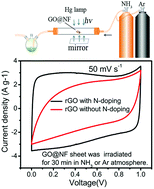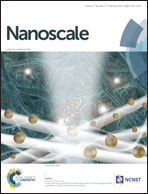NH3 assisted photoreduction and N-doping of graphene oxide for high performance electrode materials in supercapacitors†
Abstract
Nitrogen-doped graphene was synthesized by simple photoreduction of graphene oxide (GO) deposited on nickel foam under NH3 atmosphere. The combination of photoreduction and NH3 not only reduces the GO in a shorter time but also induces nitrogen doping easily. The nitrogen doped content of N-rGO@NF reaches a high of 5.99 at% with 15 min of irradiation. The nitrogen-doped graphene deposited on Ni foam (N-rGO@NF) can be directly used as an electrode for supercapacitors, without any conductive agents and polymer binders. In the electrochemical measurement, N-rGO@NF displays remarkable electrochemical performance. In particular, the N-rGO@NF irradiated for 45 min at a high current density of 92.3 A g−1 retained about 77% (190.4 F g−1) of its initial specific capacitance (247.1 F g−1 at 0.31 A g−1). Furthermore, the stable voltage window could be extended to 2.0 and 1.5 V by using Li2SO4 and a mixed Li2SO4/KOH electrolyte, and the maximum energy density was high up to 32.6 and 21.2 Wh kg−1, respectively. The results show that compared to Li2SO4, a mixed electrolyte (Li2SO4/KOH) more efficiently balances the relationship between the high energy densities and high power densities.


 Please wait while we load your content...
Please wait while we load your content...